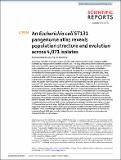Files in this item
An Escherichia coli ST131 pangenome atlas reveals population structure and evolution across 4,071 isolates
Item metadata
| dc.contributor.author | Decano, Arun Gonzales | |
| dc.contributor.author | Downing, Tim | |
| dc.date.accessioned | 2019-12-05T13:30:05Z | |
| dc.date.available | 2019-12-05T13:30:05Z | |
| dc.date.issued | 2019-11-22 | |
| dc.identifier | 264038926 | |
| dc.identifier | 8ac739f4-b3ea-49bf-a33c-96b0d2d4be66 | |
| dc.identifier | 85075518536 | |
| dc.identifier | 000498056900020 | |
| dc.identifier.citation | Decano , A G & Downing , T 2019 , ' An Escherichia coli ST131 pangenome atlas reveals population structure and evolution across 4,071 isolates ' , Scientific Reports , vol. 9 , 17394 . https://doi.org/10.1038/s41598-019-54004-5 | en |
| dc.identifier.issn | 2045-2322 | |
| dc.identifier.other | RIS: urn:BF656945771C06DC61244A0DA85AC20D | |
| dc.identifier.other | RIS: Decano2019 | |
| dc.identifier.uri | https://hdl.handle.net/10023/19076 | |
| dc.description | This work was funded by a DCU O’Hare Ph.D. fellowship and a DCU Enhancing Performance grant. | en |
| dc.description.abstract | Escherichia coli ST131 is a major cause of infection with extensive antimicrobial resistance (AMR) facilitated by widespread beta-lactam antibiotic use. This drug pressure has driven extended-spectrum beta-lactamase (ESBL) gene acquisition and evolution in pathogens, so a clearer resolution of ST131’s origin, adaptation and spread is essential. E. coli ST131’s ESBL genes are typically embedded in mobile genetic elements (MGEs) that aid transfer to new plasmid or chromosomal locations, which are mobilised further by plasmid conjugation and recombination, resulting in a flexible ESBL, MGE and plasmid composition with a conserved core genome. We used population genomics to trace the evolution of AMR in ST131 more precisely by extracting all available high-quality Illumina HiSeq read libraries to investigate 4,071 globally-sourced genomes, the largest ST131 collection examined so far. We applied rigorous quality-control, genome de novo assembly and ESBL gene screening to resolve ST131’s population structure across three genetically distinct Clades (A, B, C) and abundant subclades from the dominant Clade C. We reconstructed their evolutionary relationships across the core and accessory genomes using published reference genomes, long read assemblies and k-mer-based methods to contextualise pangenome diversity. The three main C subclades have co-circulated globally at relatively stable frequencies over time, suggesting attaining an equilibrium after their origin and initial rapid spread. This contrasted with their ESBL genes, which had stronger patterns across time, geography and subclade, and were located at distinct locations across the chromosomes and plasmids between isolates. Within the three C subclades, the core and accessory genome diversity levels were not correlated due to plasmid and MGE activity, unlike patterns between the three main clades, A, B and C. This population genomic study highlights the dynamic nature of the accessory genomes in ST131, suggesting that surveillance should anticipate genetically variable outbreaks with broader antibiotic resistance levels. Our findings emphasise the potential of evolutionary pangenomics to improve our understanding of AMR gene transfer, adaptation and transmission to discover accessory genome changes linked to novel subtypes. | |
| dc.format.extent | 13 | |
| dc.format.extent | 2639643 | |
| dc.language.iso | eng | |
| dc.relation.ispartof | Scientific Reports | en |
| dc.subject | QR Microbiology | en |
| dc.subject | QH426 Genetics | en |
| dc.subject | DAS | en |
| dc.subject.lcc | QR | en |
| dc.subject.lcc | QH426 | en |
| dc.title | An Escherichia coli ST131 pangenome atlas reveals population structure and evolution across 4,071 isolates | en |
| dc.type | Journal article | en |
| dc.contributor.institution | University of St Andrews. School of Medicine | en |
| dc.identifier.doi | https://doi.org/10.1038/s41598-019-54004-5 | |
| dc.description.status | Peer reviewed | en |
This item appears in the following Collection(s)
Items in the St Andrews Research Repository are protected by copyright, with all rights reserved, unless otherwise indicated.

